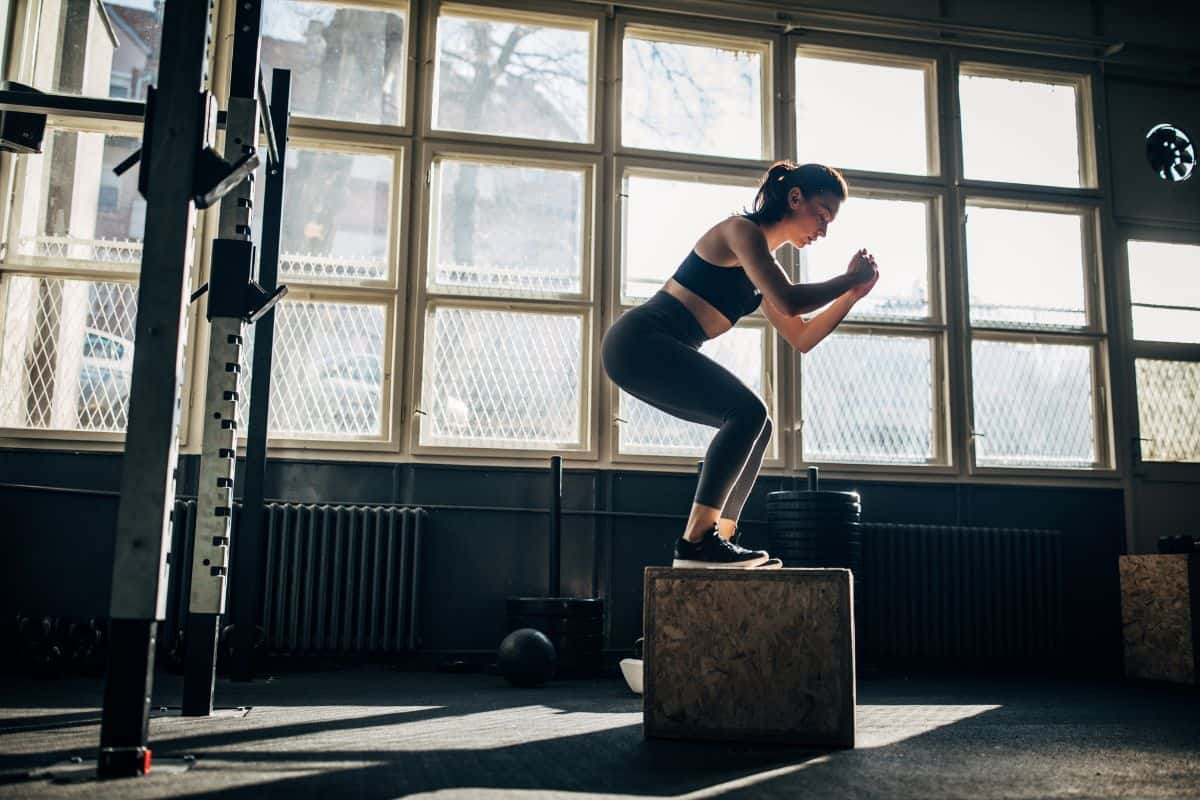If you want to pump your heart, increase blood flow, and torch decent calories in a quick time, you can do high jump exercises. The high jumping exercises are an effective way to increase your speed, power, endurance, and lower body strength.
One of the best things about high jumps is that you can do them anytime, anywhere, without any special equipment other than a box jump or firm table. You can jump in nature or the comfort of your home.
Benefits of High Jump Workout Training

High jump exercises can be fun and challenging and help you improve your overall fitness. I’ve outlined the top three benefits that will motivate you to incorporate high jump exercises into your training plan.
1. Increases Athletic Performance
High jump training is an excellent way to boost strength, power, speed, and agility. A study published in the Peer Journal has shown that plyometric jump training improved athletic performance, such as jumping, sprinting speed, strength, and endurance in males and females.1Sole S, Ramírez-Campillo R, Andrade DC, Sanchez-Sanchez J. Plyometric jump training effects on the physical fitness of individual-sport athletes: a systematic review with meta-analysis. PeerJ. 2021 Mar 1;9:e11004. doi: 10.7717/peerj.11004. PMID: 33717707; PMCID: PMC7931718.
So, if you play a sport where agility and high jump are required, such as football, basketball, and volleyball, doing regular jumping workouts will help you perform better during athletic sports.
2. Develop Lower Body Muscles
If you want to strengthen and tone your lower body muscles, you can do different variations of high jumps. The high jump workouts hit entire lower body muscles, such as the quadriceps, hamstrings, calves, and glutes, and maximize strength and muscularity.2Ramirez-Campillo R, García-Pinillos F, Nikolaidis PT, Clemente FM, Gentil P, García-Hermoso A. Body composition adaptations to lower-body plyometric training: a systematic review and meta-analysis. Biol Sport. 2022 Mar;39(2):273-287. doi: 10.5114/biolsport.2022.104916. Epub 2021 Apr 9. PMID: 35309540; PMCID: PMC8919888.
3. Support Weight Loss
To increase your fat loss, the first thing you can do is to check your macros and limit your calorie consumption. If you eat less than your body needs, you’ll lose weight over time.
The second thing you should do is to perform compound strength training and HIIT three to five times a week.
Incorporating some jumping exercises in your HIIT program will help you burn significant calories and increase weight loss.
However, it would be pretty challenging for an overweight person to perform the high jump workouts.
25 Best High Jump Exercises to Do at Home & Gym
- Front Box Jump
- Lateral Box Jump
- Broad Jump
- Skater Jump
- Scissor Jump
- Squat Jump
- Frog squat jump
- Burpee with tuck jump
- Alternating lunge jump
- Kneeling squat jump
- Single-leg deadlift jump
- Jumping Jack
- Tuck Jump
- Star Jump
- Split Jump
- Barrier Jump
- Double Leg Butt Kick
- Vertical Jumps
- Box Jump March
- Single-Leg Vertical Jump
- Stairs Squat Jump
- Pike Jump
- Single-Leg Bound
- Depth Jumps
- Weighted Jump Squats
You can also use these exercises to make a plyometric workout routine.
1. Front Box Jump

As simple as it is, this is one of the best jumping exercises you can do at home and in the gym. It will make you sweat from head to toe. To perform this exercise, you need a box or a firm table on which to jump.
How to:
As you stand, hop on the table/box and hop right back down. Repeat as many times as possible, but see that you aren’t under five.
2. Lateral Box Jump
Just as simple as the previous one, jump up on one side and jump back down on the other. You’ll need the same equipment, like the front jump box, but you’ll jump sideways instead of forward, this time.
3. Broad Jump
The broad jump is one of the advanced plyometric workouts that utilize the muscle groups differently than vertical jumping and improves your performance.3Robertson DG, Fleming D. Kinetics of standing broad and vertical jumping. Can J Sport Sci. 1987 Mar;12(1):19-23. PMID: 3594313.
How to:
Get into the squat position and jump as far as you can. That’s it. This high jump exercise doesn’t require any equipment, nor does it take special skills.
4. Skater Jump
This one comes with a stepping variation if you feel you need to step instead of jumping. The key is transferring your weight from one leg to the other, like when you rollerblade. Although the point of this high jump exercise isn’t the height or the speed, it is an immensely beneficial balancing and coordination exercise.
5. Scissor Jump
The scissor jump is also known as the split jump or lunge jump. It strengthens and tone legs and glutes and helps you jump higher.
How to:
Get into a kneeling position with one foot firmly on the floor and the knee on your other leg close to the floor, forming a 90-degree angle between your upper and lower legs. Press your heel down, jump and switch legs.
6. Squat Jump
The squat jump is one of the best exercises that anyone can do to increase their jumping performance. The best thing is you can do it at home with no equipment.
How to:
Go into the squat position as low as you can. Press your heels firmly to the floor and jump as high as possible, returning into the low squat position; don’t stop before five reps.
7. Frog Squat Jump
Among the best high jumping exercises, the frog squat jump will surprise you with its effectiveness. Very similar to the squat jumps, the frog squat jumps need you to have your legs wider apart and your feet open.
8. Burpee with a Tuck Jump
One of the most challenging exercises for high jump training, the burpee with tuck jump will definitely spend every ounce of energy you have. Instead of doing a regular burpee, you combine a burpee and a squat jump.
9. Kneeling Squat Jump
Alternating between three movements- kneeling, squat, jump, and kneeling- to make a complete jump cycle, this high jumping exercise produces excellent results if you’re consistent. It is challenging at first, as it is a full-body workout rather than just a high jump exercise.
10. Alternate Lunge Jump
Very similar to the scissor jump with one difference, your arms stay still for this jump. Your arms alternated with the scissor jump, helping you move and where your arms are in front of your chest, making you gather strength solely from your lower body.
11. Single-Leg Deadlift Jumps
To improve your vertical jump, you can incorporate the single-leg deadlift hop into your workout plan. This high jumping exercise is less challenging than it looks, but still, don’t underestimate it.
How to:
Start on one leg, with your other leg extended behind you, forming a straight line with your upper body. As you bend your knee of the leg that’s up, you bring your upper body upward, jump and go back to the starting position.
12. Jumping Jacks
Whether your pace or jump, jumping Jacks will undoubtedly make you work up some sweat. It is an excellent cardio workout that helps improve your aerobic fitness and jump you higher.
How to:
Standing with your feet together, jump your feet out and raise your arms overhead simultaneously and keep going for at least 30 seconds. Great bodyweight exercises to increase vertical jump.
13. Tuck Jumps
A tuck jump is a challenging exercise that develops the leg muscles. It helps scale up the performance of athletes who play high-energy sports like basketball, netball, and soccer.
How to:
Just like the name tells you, you jump and tuck your knees as close to your abs as possible. It helps to place your palms in front of you and touch them with your knees for better orientation.
14. Star Jumps
Star jump is an excellent total body cardio exercise that helps improve cardiovascular fitness, endurance, and strength. It’s nearly similar to jumping jacks.
How to:
Standing upright with your feet together, jump high in the air by bringing your feet and arms out together at the same time so your body forms a star or cross shape. Continue performing for the recommended duration.
15. Split Jump
Much like the alternate lunge jump, here, too, your arms aren’t active, but they are loose next to your body. The movement resembles the front split, hence the name.
It hits your lower body muscles at a different angle, increasing strength and mobility.
16. Barrier Jump
Barrier jump is a part of plyometric training that helps you jump higher and boost performance.
How to:
You’ll need something to jump over. Put a rope in the middle of the room and jump from one side of the rope to the other, staying on the ground as short as possible.
17. Double Leg Butt Kick
The double leg butt kick is a plyometric exercise that works throughout the body, including the thighs, glutes, and core. It is an advanced variation of high jumps that requires you to touch your buttock with your feet in the air. You can be good at it with consistent practice.
How to perform:
As simple as this jump could be, this jump is nothing more than jumping and kicking your butt with your heels. When you return to the ground, bend your knees partially to amortize the landing.
18. Vertical Jump
The vertical jump is the foundational plyometric workout that strengthens lower body muscle power and increases the height of the jump. It is widely performed by various athletes who want to excel in their sports, particularly basketball and soccer.
How to:
You start in a vertical position, only slightly bending your knees to kick-start the jump. You create an explosive jump with as little crouching as possible and remain in the same vertical position while off the ground.
19. Box Jump March
Do it walking or jumping; this jumping exercise will definitely drain you. Get the box/table again and jump, placing one leg on the box while the other is in the air, creating a marching-like movement. As you step down, the movement itself will guide you to take a step back and march backward before coming back to the front.
20. Single-Leg Vertical Jump
Like the deadlift single-leg jumps, you start lower with a bent knee for the single-leg vertical jump. The movement and the objective are the same.
21. Stairs Squat Jump
Stairs squat jump is a great exercise for stimulating the leg muscles and improving fitness. It gets your heart pumped, burn decent calories, and improves cardiovascular fitness. The best thing is you can do it in the open nature.
How to:
This jump exercise is the same as the squat jump, but while climbing the stairs.
22. Pike Jump
A bit more challenging, but an excellent bodyweight exercise to increase vertical jump. You jump while bringing your hands over your head, holding them. Your legs are straight in the air, and at your highest point, you bring them as forward as possible, engaging your abs.
23. Single Leg Hops
This is a great high jump exercise for increasing both the height and the length of your jump. It is very simple to do; you basically run on one leg.
How to:
Stand firmly on one leg and bring your other knee bent up and lock your hip in that position. Bend the knee of the leg you are standing on and jump as far as you can. Jump around the room as long as you can, then switch legs.
24. Depth Jumps
This jump will require a box or a firm table. Climb onto the box/table, keep your legs wider than your hips, and bend your knees slightly.
The jump you make is a squad jump as low as you can and jump twice more. To get the optimal results, repeat the jump four more times.
25. Weighted Jump Squats
If you want to scale your fitness to the next level, you can do weighted jump squats. The movement is just like the jump squats, but with weights. It challenges your fitness and pushes your limit.
Weighted jump squats increase the height of your jumps, as you strengthen your muscles and increase your stamina.
The best equipment you can use to perform weighted squats is a set of dumbbells, as they are easy to carry compared to barbells and kettlebells.
How Should High Jump Workout Routine Look Like?
High jumping takes consistency and perseverance, especially since it is challenging, even if you have a history of working out regularly. To maintain consistency, you need a routine, and what’s even more, you need a good routine. A good routine is a routine that incorporates several types of jumps ranging in difficulty and repetitions.
The first step of your routine is to stretch and stretch well. I’d recommend a full-body general stretching session, from the neck to the feet.
The second step is to choose the high jump exercise that is easiest for you to do so that you gain enthusiasm and motivation to continue. The psychological state has a tremendous impact on the successfulness of your routine. If you start with something that is too hard for you, chances are you’ll get frustrated and stop.
The second step is to proceed with a jump that is a little more challenging and add one more repetition compared to the first jump.
The third jump you do will be the culmination, and this should be the one that you find the most difficult with two more repetitions compared to the second jump.
The fourth jump should be easier than the previous one, with one repetition more than the last one.
The fifth jump will be the first jump, with one more added repetition in relation to the fourth one.
And you end as you started, with another general full-body stretching.
To illustrate this better, you can start with jumping jacks and squat jumps, proceed with frog jumps, then tuck jumps, and next come to the weighted jump squats, and jumping jacks again.
Try out all the jumps on this list and make up your own routine following the instructions provided in this section.
This routine is just a sample; feel free to adjust the number, difficulty, and repetitions of the jumps as you see fit.
How to Improve Your High Jumps?
High jump exercises are super effective but challenging and won’t go smoothly from the get-go. Timing your meals and knowing what to eat before is crucial when it comes to high jumping.
High jumps are cardio exercises, so you’ll need the energy to do them, meaning that you shouldn’t high jump on an empty stomach. On the other hand, you’ll need all you’ve got, and your energy will be focused on the jumps, meaning that it won’t sit well if you’ve just eaten.
To optimize your high jumping session, you need to give your meal enough time to digest, but not too long, so you start feeling hungry. Therefore, the best time to do high jumps would be at least 40 minutes after your meal.
Meals that are high in protein, fiber, and carbs are best to give yourself the best possible fuel. Try combining lean protein, such as chicken, pork tenderloin, or fish, with white rice and a salad. You can also go for a spinach salad, lentil, or a protein-rich leafy green combination with a highly energizing grain.
If you make high jumping a part of your routine and plan on doing it for a long time, you’ll need to permanently adapt your eating habits to suit your physical activity. A high protein, low-carb diet works best in the long run.
Frequently Asked Questions (FAQs)
Who should avoid high jumping exercises?
Plyometric high jump exercises are challenging and require substantial strength and explosive power. So it’s a good idea to consult with your first, especially if you want to do them for the first time.
And avoid if you have heart disease, high blood pressure, high cholesterol, diabetes, and bone or joint issue. And not suitable for pregnant and breastfeeding women.
When is the best time to perform plyometrics Jumps?
The plyometric high jump exercises are quick and explosive and require optimum energy to perform them. That’s why it’s best to do them when you feel energetic, whether morning, afternoon or evening.
How often Should you do High Jump Workouts?
High jump workouts aim to develop muscle power and explosiveness, not conditioning and fatigue. That’s why you should perform them only two to three times a week with 48 hours of recovery between sessions. However, if you want, you can push your limits further as long as you maintain the quality of training.
References
- 1Sole S, Ramírez-Campillo R, Andrade DC, Sanchez-Sanchez J. Plyometric jump training effects on the physical fitness of individual-sport athletes: a systematic review with meta-analysis. PeerJ. 2021 Mar 1;9:e11004. doi: 10.7717/peerj.11004. PMID: 33717707; PMCID: PMC7931718.
- 2Ramirez-Campillo R, García-Pinillos F, Nikolaidis PT, Clemente FM, Gentil P, García-Hermoso A. Body composition adaptations to lower-body plyometric training: a systematic review and meta-analysis. Biol Sport. 2022 Mar;39(2):273-287. doi: 10.5114/biolsport.2022.104916. Epub 2021 Apr 9. PMID: 35309540; PMCID: PMC8919888.
- 3Robertson DG, Fleming D. Kinetics of standing broad and vertical jumping. Can J Sport Sci. 1987 Mar;12(1):19-23. PMID: 3594313.






